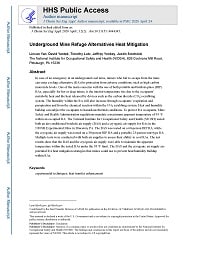Mining Publication: Underground Mine Refuge Alternatives Heat Mitigation
Original creation date: April 2020
Authors: L Yan, D Yantek, T Lutz, J Yonkey, J Srednicki
In case of an emergency in an underground coal mine, miners who fail to escape from the mine can enter a refuge alternative (RA) for protection from adverse conditions, such as high carbon monoxide levels. One of the main concerns with the use of both portable and built-in-place (BIP) RAs, especially for hot or deep mines, is the interior temperature rise due to the occupants’ metabolic heat and the heat released by devices such as the carbon dioxide (CO2) scrubbing system. The humidity within the RA will also increase through occupants’ respiration and perspiration and from the chemical reaction within the CO2 scrubbing system. Heat and humidity buildup can subject the occupants to hazardous thermal conditions. To protect RA occupants, Mine Safety and Health Administration regulations mandate a maximum apparent temperature of 95 °F within an occupied RA. The National Institute for Occupational Safety and Health (NIOSH) tested both an air-conditioned borehole air supply (BAS) and a cryogenic air supply for RAs in the NIOSH Experimental Mine in Bruceton, PA. The BAS was tested on a 60-person BIP RA, while the cryogenic air supply was tested on a 30-person BIP RA and a portable 23-person tent-type RA. Multiple tests were conducted with both air supplies to assess their ability to cool RAs. The test results show that the BAS and the cryogenic air supply were able to maintain the apparent temperature within the tested RAs under the 95 °F limit. The BAS and the cryogenic air supply are potential RA heat mitigation strategies that mines could use to prevent heat/humidity buildup within RAs.

- Development of Heat Mitigation Systems for Refuge Alternatives used in Underground Coal Mines
- Emergency Escape and Refuge Alternatives
- Estimation of Metabolic Heat Input for Refuge Alternative Thermal Testing and Simulation
- How to Operate a Refuge Chamber: A Quick Start Guide
- Investigation of Temperature Rise in Mobile Refuge Alternatives
- Portable Refuge Alternatives Temperature and Humidity Tests
- RA Heat Mitigation System Utilizing Advanced Liquid Air Technologies
- Refuge Alternatives in Underground Coal Mines
- Technology News 537 - NIOSH Develops New Mine Refuge Chamber Training
- When Do You Take Refuge? Decisionmaking During Mine Emergency Escape